The banjo is a stringed instrument with a thin membrane stretched over a frame or cavity to form a resonator. The membrane is typically circular, and usually made of plastic, or occasionally animal skin. Early forms of the instrument were fashioned by African Americans in the United States. The banjo is frequently associated with folk, bluegrass and country music, and has also been used in some rock, pop and hip-hop. Several rock bands, such as the Eagles, Led Zeppelin, and the Grateful Dead, have used the five-string banjo in some of their songs. Historically, the banjo occupied a central place in Black American traditional music and the folk culture of rural whites before entering the mainstream via the minstrel shows of the 19th century. Along with the fiddle, the banjo is a mainstay of American styles of music, such as bluegrass and old-time music. It is also very frequently used in traditional ("trad") jazz. Banjo is also a common instrument for Caribbean genres like Biguine, Calypso and Mento.

The classical guitar is a member of the guitar family used in classical music and other styles. An acoustic wooden string instrument with strings made of gut or nylon, it is a precursor of the modern acoustic and electric guitars, both of which use metal strings. Classical guitars derive from the Spanish vihuela and gittern of the fifteenth and sixteenth century. Those instruments evolved into the seventeenth and eighteenth-century baroque guitar—and by the mid-nineteenth century, early forms of the modern classical guitar.

The guitar is a fretted musical instrument that typically has six strings. It is usually held flat against the player's body and played by strumming or plucking the strings with the dominant hand, while simultaneously pressing selected strings against frets with the fingers of the opposite hand. A plectrum or individual finger picks may also be used to strike the strings. The sound of the guitar is projected either acoustically, by means of a resonant chamber on the instrument, or amplified by an electronic pickup and an amplifier.

A musical ensemble, also known as a music group or musical group, is a group of people who perform instrumental or vocal music, with the ensemble typically known by a distinct name. Some music ensembles consist solely of instrumentalists, such as the jazz quartet or the orchestra. Other music ensembles consist solely of singers, such as choirs and doo wop groups. In both popular music and classical music, there are ensembles in which both instrumentalists and singers perform, such as the rock band or the Baroque chamber group for basso continuo and one or more singers. In classical music, trios or quartets either blend the sounds of musical instrument families or group together instruments from the same instrument family, such as string ensembles or wind ensembles. Some ensembles blend the sounds of a variety of instrument families, such as the orchestra, which uses a string section, brass instruments, woodwinds and percussion instruments, or the concert band, which uses brass, woodwinds and percussion.

The viol, viola da gamba, or informally gamba, is any one of a family of bowed, fretted, and stringed instruments with hollow wooden bodies and pegboxes where the tension on the strings can be increased or decreased to adjust the pitch of each of the strings. Frets on the viol are usually made of gut, tied on the fingerboard around the instrument's neck, to enable the performer to stop the strings more cleanly. Frets improve consistency of intonation and lend the stopped notes a tone that better matches the open strings. Viols first appeared in Spain in the mid-to-late 15th century, and were most popular in the Renaissance and Baroque (1600–1750) periods. Early ancestors include the Arabic rebab and the medieval European vielle, but later, more direct possible ancestors include the Venetian viole and the 15th- and 16th-century Spanish vihuela, a six-course plucked instrument tuned like a lute that looked like but was quite distinct from the four-course guitar.

The hurdy-gurdy is a string instrument that produces sound by a hand-crank-turned, rosined wheel rubbing against the strings. The wheel functions much like a violin bow, and single notes played on the instrument sound similar to those of a violin. Melodies are played on a keyboard that presses tangents—small wedges, typically made of wood—against one or more of the strings to change their pitch. Like most other acoustic stringed instruments, it has a sound board and hollow cavity to make the vibration of the strings audible.
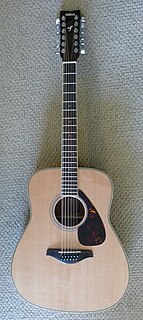
A twelve-string guitar is a steel-string guitar with 12 strings in six courses, which produces a thicker, more ringing tone than a standard six-string guitar. Typically, the strings of the lower four courses are tuned in octaves, with those of the upper two courses tuned in unison. The gap between the strings within each dual-string course is narrow, and the strings of each course are fretted and plucked as a single unit. The neck is wider, to accommodate the extra strings, and is similar to the width of a classical guitar neck. The sound, particularly on acoustic instruments, is fuller and more harmonically resonant than six-string instruments. The 12-string guitar can be played like a 6-string guitar as players still use the same notes, chords and guitar techniques like a standard 6-string guitar, but advanced techniques might be tough as players need to play or pluck two strings simultaneously.
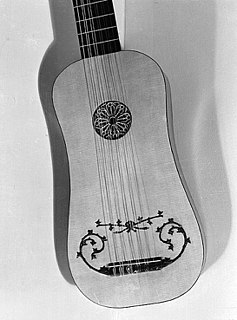
The vihuela is a 15th-century fretted plucked Spanish string instrument, shaped like a guitar but tuned like a lute. It was used in 15th- and 16th-century Spain as the equivalent of the lute in Italy and has a large resultant repertory. There were usually five or six doubled strings.
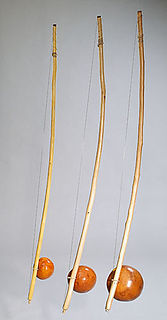
The berimbau is a single-string percussion instrument, a musical bow, originally from Africa, that is now commonly used in Brazil.
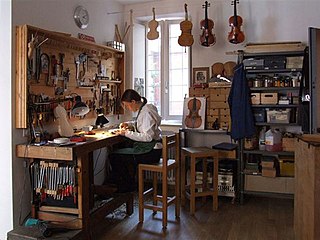
A luthier is a craftsperson who builds or repairs string instruments that have a neck and a sound box. The word "luthier" is originally French and comes from the French word for lute. The term was originally used for makers of lutes, but it came to be used already in French for makers of most bowed and plucked stringed instruments such as members of the violin family and guitars. Luthiers, however, do not make harps or pianos; these require different skills and construction methods because their strings are secured to a frame.

The seven-string guitar adds one additional string to the more common six-string guitar, commonly used to extend the bass range or also to extend the treble range.
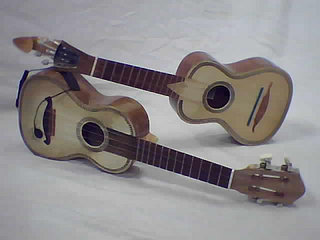
The cavaquinho is a small Portuguese string instrument in the European guitar family, with four wires or gut strings.

Cordel literature (from the Portuguese term, literatura de cordel, literally “string literature”, [koʁˈdɛw]) are popular and inexpensively printed booklets or pamphlets containing folk novels, poems and songs. They are produced and sold in street markets and by street vendors in Brazil, mainly in the Northeast. They are so named because they are hung from strings to display them to potential customers, and the word for rope in Portuguese is corda, from which the term cordel is derived.

The viola caipira, often simply viola, is a Brazilian ten-string guitar with five courses of strings arranged in pairs. It was introduced in the state of São Paulo, where it is widely played as the basis for the música caipira, a type of folk-country music originating in the caipira country of south-central Brazil.
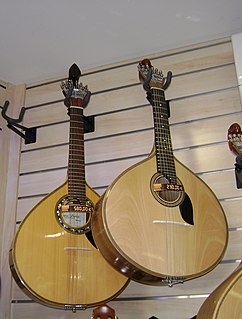
The Portuguese guitar or Portuguese guitarra is a plucked string instrument with twelve steel strings, strung in six courses of two strings. It is one of the few musical instruments that still uses watch-key or Preston tuners. It is iconically associated with the musical genre known as Fado, and is now an icon for anything Portuguese.

The gittern was a relatively small gut-strung, round-backed instrument that first appears in literature and pictorial representation during the 13th century in Western Europe. It is usually depicted played with a quill plectrum, as can be seen clearly beginning in manuscript illuminations from the thirteenth century. It was also called the guiterna in Spain, guiterne or guiterre in France, the chitarra in Italy and Quintern in Germany. A popular instrument with court musicians, minstrels, and amateurs, the gittern is considered an ancestor of the modern guitar and other instruments like the mandore, bandurria and gallichon.

The Palace of Queluz is an 18th-century palace located at Queluz, a city of the Sintra Municipality, in the Lisbon District, on the Portuguese Riviera. One of the last great Rococo buildings to be designed in Europe, the palace was conceived as a summer retreat for Dom Pedro of Braganza, later to become husband and then king consort to his own niece, Queen Maria I. It served as a discreet place of incarceration for Queen Maria as her descent into madness continued in the years following Dom Pedro's death in 1786. Following the destruction by fire of the Ajuda Palace in 1794, Queluz Palace became the official residence of the Portuguese prince regent John VI, and his family and remained so until the royal family fled to the Portuguese colony of Brazil in 1807 following the French invasion of Portugal.
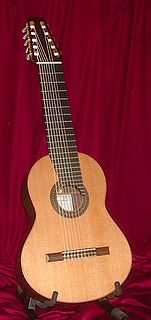
There are many varieties of ten-string guitar, including:
The viola da Terceira is a stringed musical instrument of the guitar family, from the Portuguese islands of the archipelago of the Azores, associated with the island of Terceira.

Lutes are stringed musical instruments that include a body and "a neck which serves both as a handle and as a means of stretching the strings beyond the body".


















